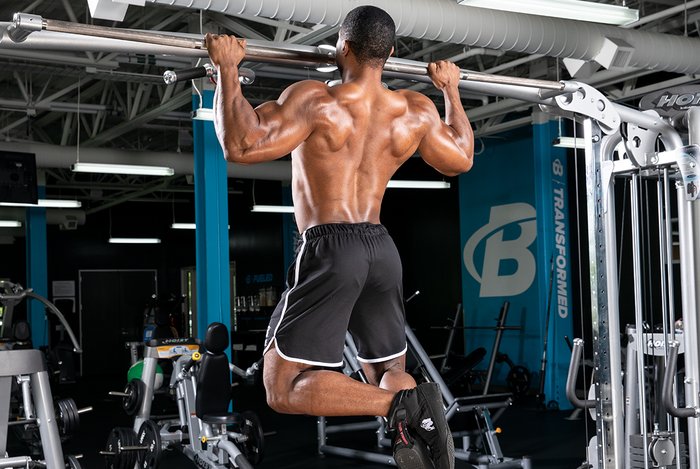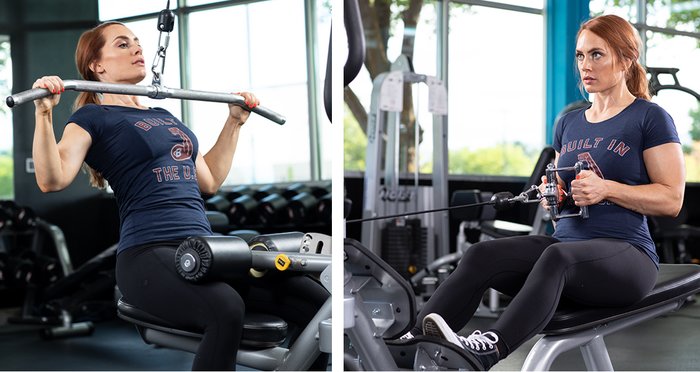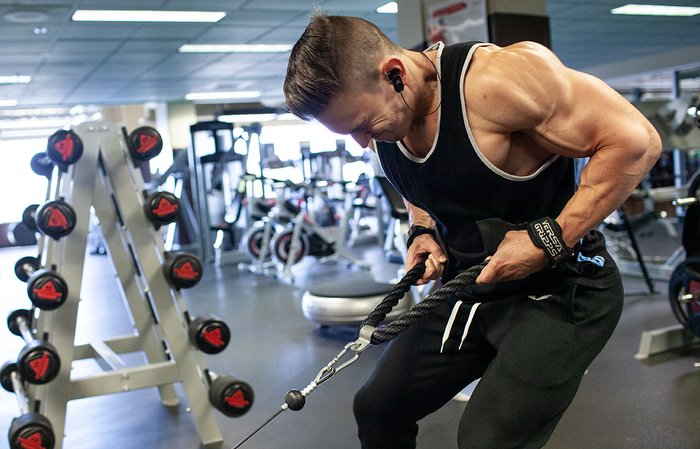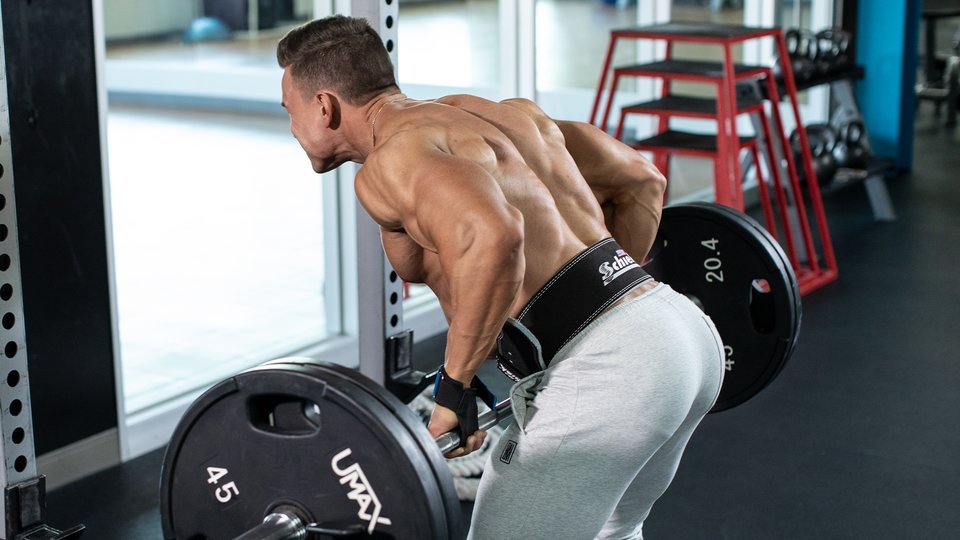For many lifters, back training is a bit of an enigma. It is not as satisfying as a tough chest or shoulder workout, and often requires much more work to actually build an impressive back. That’s why on “back day,” gyms are usually full of lifters half-heartedly going through the motions: chin-ups, rows, hyperextensions, repeat—week in, week out, with little progress to show for it.
If you’ve been guilty of blaming “bad genetics” for your lack of back, then you owe it to yourself to try these simple techniques to spice up your back training. Hit them hard and get some well-earned thickness on those lats and rhomboids!
Variation 1: Chin-up Mechanical Dropset
For this protocol, a multi-grip chin-up station that allows for pronated, neutral, and supinated chin-ups is a must. You’ll be doing a dropset, but unlike a traditional dropset where the weights go down once you hit the wall, this is an “anatomical” or mechanical dropset. That means it takes advantage of your body’s anatomy and favorable leverages to complete additional repetitions.

Start by repping out as many pronated (palms facing away from you) pull-ups as you can manage. Without resting, switch to a fairly wide neutral grip, and bust out a few more reps. Then, switch to a narrow neutral grip. Finally, finish with a supinated chip-up grip for a total of four chin-up variations in a single set. Even if you only get a few reps on those last couple of variations, you’ll feel the muscular overload big time.
Here’s why it works: In the pronated position, the main elbow flexors, the biceps brachii, can’t assist much with the pull. This places full emphasis on the lats. In the neutral-grip position, the brachioradialis assists in the pull. And in the supinated position, the biceps brachii get in on the action, allowing for additional repetitions to be completed.
Variation 2: Swap Barbell Rows for Pendlay Rows or Cheat Rows
The Pendlay row gets its name from weightlifting and powerlifting coach Glenn Pendlay, who loves it as a strength-building assistance lift for the deadlift. But it’s also just a powerful back-builder, period.
Basically, it’s a twist on the traditional barbell row where the bar must start and finish on the ground for each rep. This makes the movement stricter than the barbell row, since you’re unable to use your lower back and hamstrings to give a bit of bounce to the bar. For those with lower back pain, the Pendlay row feels better, as tension comes off the lower back between each rep, providing a slight rest.
On the opposite end of the spectrum is the cheat row. Start in a traditional barbell row stance and use your hamstrings to provide a slight bounce to the bar to start each rep. This movement functions as an overload pattern as the weight used can be 10-20 percent higher than the weight you would use for a regular barbell row.
Use both in the same training cycle, or alternate between them. They lend themselves to lower rep ranges like 5-8, but also 8-12 to add both size and strength.
Variation 3: Pair Pull-downs With Seated Rows
We find that lats and middle back respond very well to a lot of volume. That means that supersets and paired sets should be in the mix somewhere! One of our favorites is to pair lat pull-downs with seated rows for total back development.
While the lat pull-down targets the latissimus dorsi for back width, the seated row targets the rhomboid major and minor and lower traps for back thickness. The result is a potent back-building combination that will leave your upper back sore (in a good way) for days.

Try hitting 4 sets of 12-16 reps of each one. If you can’t get both machines at the same time, just use a single cable stack and bring a bench over to sit on, and grab the handle of your choice.
Variation 4: Add a Band to Dumbbell Rows
Much like the Pendlay row, this is a twist on a classic movement that helps many lifters “feel” it working better.
To do this, loop one end of a resistance band to a dumbbell and the other end to something that won’t move, like the dumbbell rack or power cage. Next, take a stance similar to the standard single dumbbell row, with the resistance coming largely at a horizontal line.
Row the weight from the floor to your hip. The resistance from the band will force you to pull in an arc, which creates a major elongation of the lat muscle and thus, a lot of stimulus. Using a very rigid technique here—no cheating!—try to hit 3-4 sets of 12-16 reps.
Variation 5: Cable Stack Back Triset
This is one of our favorite back builders at JK Conditioning, the facility we run. Kind of like the chin-up mechanical dropset, this triset works by arranging the exercises in descending order of difficulty. The three exercises used here are the half-kneeling high cable row, the straight-arm pull-down, and the low cable row.

Half-Kneeling High Cable Row: Like the name suggests, this row is done with one knee on the ground, and a cable at the highest setting on the cable tower. Using a neutral grip and keeping your posture rigid, row the weight from the high cable position until your hands make contact with your chest. Squeeze your shoulder blades together to ensure you engage the middle back.
Straight-Arm Pull-Down: Using the same high cable position and standing with your feet wider than hip-width apart, grab the handles with a palms-down grip. Keeping your elbows straight, bring the handles from the high position to between your legs, making sure to engage the lats. To ensure a good squeeze through the lats, imagine squeezing an orange in your armpits. It seems weird, but it works!
Low Cable Row: Move the cable to the low position now. Grab the handle with a neutral grip and stand with a hip-width stance. Bend at the knees and keep a rigid back position, similar to the starting position of a deadlift. Keeping this posture, row the weight to your stomach and squeeze your shoulder blades hard each rep.
For a serious back pump, perform all three without rest and aim for 8-12 reps of the half kneeling high row, 12-16 reps of the straight-arm press-down, and 16-20 reps of the low cable row.
Don’t Look Back!
Don’t resign yourself to life with invisible lats! Mix any of these variations into your regular back training and reap the rewards of training variety. Or, if you are feeling particularly disappointed with your current back training, replace your current program with all five for a few weeks. You can line them up 1-5 and build a solid back workout you will feel for days afterward.
If you like to upgrade your workouts with unique movements and deep coaching insight, check out True Muscle: 9 Weeks to Elite Fitness with Nick Tumminello and former NFL star Steve Weatherford. Over nine weeks, you’ll get a master class in lifting technique, programming, and all the little things that make a huge difference in your results!
